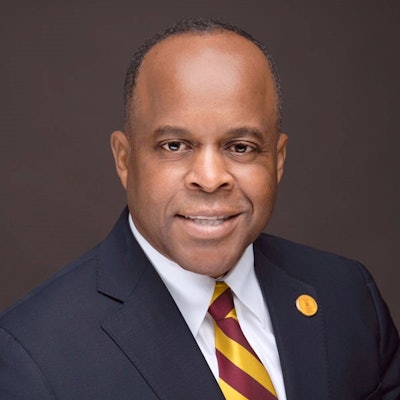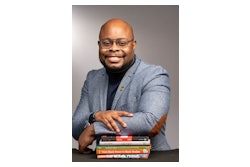I am a proud first-generation college president. Neither of my parents was able to attend college. Amidst the tumultuous battles of the Civil Rights Movement, they worked the fields in the same rural Alabama town where they raised me. At an early age, I can recall my mother telling me, “I want you to finish high school and go to college. Somebody has to do something a little different from what your father and I have done.” With my parents' support and encouragement, I obtained my bachelor’s in English from Alabama Agricultural and Mechanical University. From there, I went on to obtain my master’s and doctorate from Virginia State University and Indiana University of Pennsylvania, respectively. Now, as the ninth President of Central State University and the father of two sons of my own, I strive to promote intergenerational success for first-generation students and their families. Dr. Jack Thomas
Dr. Jack Thomas
The category of “first-generation student” has become widespread in higher education discourse in the past 20 years. Legislative, research, and institutional definitions vary in their details, but the idea is that the student's parents do not have college degrees (Sharpe, 2017). “First-generation student” attempts to capture students whose “parents have little or no experience navigating the academic, financial and cultural barriers to higher education” (Sharpe, 2017). In the United States, over 40% of first-year students are first-generation, making first-generation a significant educational demographic (Starz, 2022).
First-generation trends are useful to measure upward economic mobility because educational attainment and socioeconomic status are closely related. With each increase in educational degree or certification, average income rises (U.S. Bureau of Labor Statistics, 2018). Thus, to promote upward economic mobility, first-generation students should obtain college degrees at the same rate as their peers whose parents have college degrees (also known as continuing-generation students).
However, first-generation students are less likely to enroll in post-secondary education than their continuing-generation peers (Bennett et al., 2018), and they are less likely to continue in college after their first year (RTI International, 2019). Ultimately, first-generation students are less likely to graduate with a bachelor’s degree in six years than their continuing-generation peers (RTI International, 2019). This educational achievement gap is not attributable to any difference in intelligence, ability, or aptitude. Rather, it is a combination of systemic issues that disadvantage first-generation students in their pursuit of a four-year degree. These disadvantages result in decreased opportunities for upward economic mobility.
Because first-generation students have less familiarity with the college process, they can face increased barriers to attending and graduating from four-year institutions when compared to their continuing-generation peers. First-generation students may be less familiar with the application process (including the Common Application and other platforms or school-specific processes), the FAFSA (Free Application for Federal Student Aid), declaring or switching a major, the benefits of attending office hours, etc. These mechanisms can be confusing and stressful for any student but may be especially so for first-generation students who may not know who or what to ask. Resources related to these processes can be found at the end of this article.
Furthermore, under the umbrella of “first-generation,” students have intersectional identities that may complicate their attainment of a four-year degree. First-generation students are “predominantly non-white and from low-income backgrounds” (PNPI, 2021). First-generation students of color may face discrimination or racism that can cause stress and other ill effects (Beresin & Watkins, 2021). Low-income first-generation students may face increased financial pressure, amounting to the primary reason first-generation students leave programs without a degree (Beresin & Watkins, 2021).
Understanding and working to remove these barriers is essential to making upward economic mobility a reality for first-generation students. As the ninth President of Central State University, Ohio’s only public HBCU, I have the honor of continuing a 135-year tradition of serving first-generation students. Nearly 50% of our students are first-generation, which is consistent with Minority-Serving Institutions that, on average, serve a large percentage of first-generation students (PNPI, 2021).
It is up to the University to address the needs of our first-generation students to foster an environment where they can succeed and thrive. On average, first-generation students take out more loans to finance their education than their second-generation peers (PNPI, 2021). To reduce this financial burden, it is essential that we make college education as affordable as it can be. In line with this mission, I am proud that Central State remains the most affordable option among 4-year public universities in Ohio and has been recognized by US News and World Report as a top 20 institution for social mobility in the Midwest.
To further support first-generation students, universities should supplement familial experience with the college process by providing programming and assistance to students and their families. The Central State Office of Admissions conducts regular virtual information sessions with area guidance counselors, students, and families, walking them through the application, enrollment, and financial aid processes. Once a student is admitted, we guide them through selecting housing, enrolling in courses, and everything in between. Throughout their time at Central State, first-generation students have access to Student Support Services, a federally funded TRIO program designed to assist first-generation students to stay in school, in good academic standing, and successfully graduate with a bachelor’s degree.
Furthermore, as a part of the Nine Strategic Priorities I enacted upon becoming President, each incoming first-year is paired with a professional mentor who works to ease the transition from high school to college. Mentorship has been shown to be effective in providing students with support and knowledge that helps them succeed academically and professionally (Zinshteyn, 2016). This one-on-one attention can be particularly valuable for first-generation students who otherwise may not know who or what to ask (Zinshteyn, 2016).
From my experience, I know that it is nearly impossible to overstate the importance of mentorship, especially as a first-generation college student. My parents’ support alone would not have been able to get me through my bachelor’s, master’s, and doctorate degrees. At each step in my academic career, I was fortunate to have strong, African American male mentors who guided me and pushed me further. By establishing this mentorship program, Central State is formalizing and expanding upon the kind of support I was blessed with throughout my academic career. The mentorship program and other vital Central State initiatives, such as our Counseling Services, are designed to foster a community of support for our first-generation students and other students from diverse economic and academic backgrounds.
Central State and other universities committed to first-generation students recognize both the challenges and strengths that our first-generation students bring with them to campus. First-generation students “tend to have higher college satisfaction than non-first gen peers, increased learning gains, and a greater ability to overcome setbacks of all kinds” (Beresin & Watkins, 2021). They also place a higher value on their education and are less likely to question if enrolling in college was the “right decision” (Georgetown University, 2018). These strengths, among others, make first-generation students valuable assets to the campus community inside and out of the classroom.
After graduation, many first-generation students go on to successful careers, becoming leaders in their fields. First-generation students make up some of the most influential figures in the United States. Oprah Winfrey’s mother was a housemaid (Williams, 2019). Ruth Bader Ginsburg’s father was a fur manufacturer, and her mother was unable to pursue a career (Academy of Achievement, 2022). John Lewis’s parents were sharecroppers (Williams, 2019). Colin Powell’s mother was a seamstress, and his father was a shipping clerk (Williams, 2019). Michelle Obama’s mother was a homemaker, and her father worked for the water department (Williams, 2019). All of these individuals and millions of others across the United States are first-generation students who have done something different than their parents before them.
Whether they go on to the Supreme Court, the military, a local elementary school, a law firm, or anywhere in between, first-generation students benefit their families and communities. First-generation students who obtain a four-year degree increase the likelihood that their family members will do the same (Center for First Generation Student Success, 2020), creating an intergenerational effect. If we invest in our first-generation students, it will pay off, just like it has for my family and me.
As I reflect on my own journey from first-generation college student to first-generation college president, I am reminded of a visit to my father’s farm in Alabama several years ago. I took some pictures of the cows in the field and offhandedly sent them to friends with the caption, “I don’t know why I ever left the farm. It is so peaceful here.” A good friend and mentor responded, “so that you can see more than just a cow.” His words have stuck with me all these years later because, ultimately, that’s what I believe higher education, especially for first-generation students, is all about – exposure to new and different ideas, people, places, and cultures. If we do our job, by the time students graduate, they are equipped with the necessary tools, knowledge, and confidence to transform the world.
Dr. Jack Thomas is president of Central State University in Ohio.
Resources
Common Application: a centralized application platform for over 900 colleges and universities across the country (https://www.commonapp.org/)
Common Black College Application: a $20 centralized application for 68 member HBCUs, including Central State University (https://commonblackcollegeapp.com/)
Declaring and Switching a Major:
- See Dave Tomar’s “Focus on Declaring a Major” for general information about college majors and how to choose them: https://academicinfluence.com/resources/guidance/focus-declaring-major
- See Allison Wignall’s “Can I Switch College Majors? Should I?” for a discussion on changing majors: https://www.collegeraptor.com/find-colleges/articles/college-majors-minors/can-switch-college-majors/#:~:text=Never%20fear%E2%80%93you%20can%20change,want%20to%20change%20it%20up.
Free Application for Federal Student Aid (FAFSA): the process through which students can qualify for financial aid, including federal grants, work-study, and loans (https://studentaid.gov/)
Office Hours: See Geneva Stein’s “13 Reasons Why You Should Attend Office Hours” for an explanation of office hours and why students should attend them: https://medium.com/study-kit/13-reasons-why-you-should-attend-office-hours-20373bb9c6fc
TRIO Program: Federal program designed to assist students who are first-generation, low-income, or who have a disability (https://www2.ed.gov/about/offices/list/ope/trio/index.html)
Bibliography
Academy of Achievement. (2022, May 9). Ruth Bader Ginsburg.
https://achievement.org/achiever/ruth-bader-ginsburg/
Bennett, C. T., Cataldi, E. F., & Chen, Xianglei. (2018, February). First-Generation Students:
College Access, Persistence, and Postbachelor’s Outcomes. US Department of
Education. file:///C:/Users/klouthain/Downloads/Cataldi_Bennett_Chen_First-Gen_2018421.pdf
Beresin, E. & Watkins, K. B. (2021, November 6). The Challenges of First Generation College
Students. Psychology Today. https://www.psychologytoday.com/us/blog/inside-out- outside-in/202111/the-challenge-first-generation-college-students
Center for First Generation Student Success. (2020). About the Center: Meeting an Urgent Need. https://firstgen.naspa.org/journal-and-research/national-data-fact-sheets-on-first
-generation-college-students/national-data-fact-sheets
Georgetown University. (2018, June 15). Survey explores first-generation student strengths,
areas of need. https://feed.georgetown.edu/access-affordability/survey-explores-first-generation-student-strengths-areas-of-need/
PNPI. (2021, February 1). First-Generation Students in Higher Education.
https://pnpi.org/first-generation-students/
RTI International. (2019). First Year Experience, Persistence, and Attainment of First-
generation College Students. NASPA. https://firstgen.naspa.org/files/dmfile/FactSheet- 02.pdf
Sharpe, R. (2017, November 3). Are You First Gen? Depends on Who’s Asking? The New York
Times. https://www.nytimes.com/2017/11/03/education/edlife/first-generation-college
-admissions.html
Startz, D. (2022, April 25). First-generation college students face unique challenges. Brookings. https://www.brookings.edu/blog/brown-center-chalkboard/2022/04/25/first-generation- college-students-face-unique-challenges/
U.S. Bureau of Labor Statistics. (2018, April). Data on Display: Measuring the Value of
Education. https://www.bls.gov/careeroutlook/2018/data-on-display/education- pays.htm#:~:text=As%20the%20chart%20shows%2C%20the,than%20a%20high%20school%20diploma
Williams. (2019, August 2). 1st: Prominent First-Generation Students.
https://libguides.williams.edu/FIRSTexhibit2019
Zinshteyn, M. (2016, March 13). How to Help First-Generation Students Succeed. The Atlantic.
https://www.theatlantic.com/education/archive/2016/03/how-to-help-first-generation- students-succeed/473502/



















